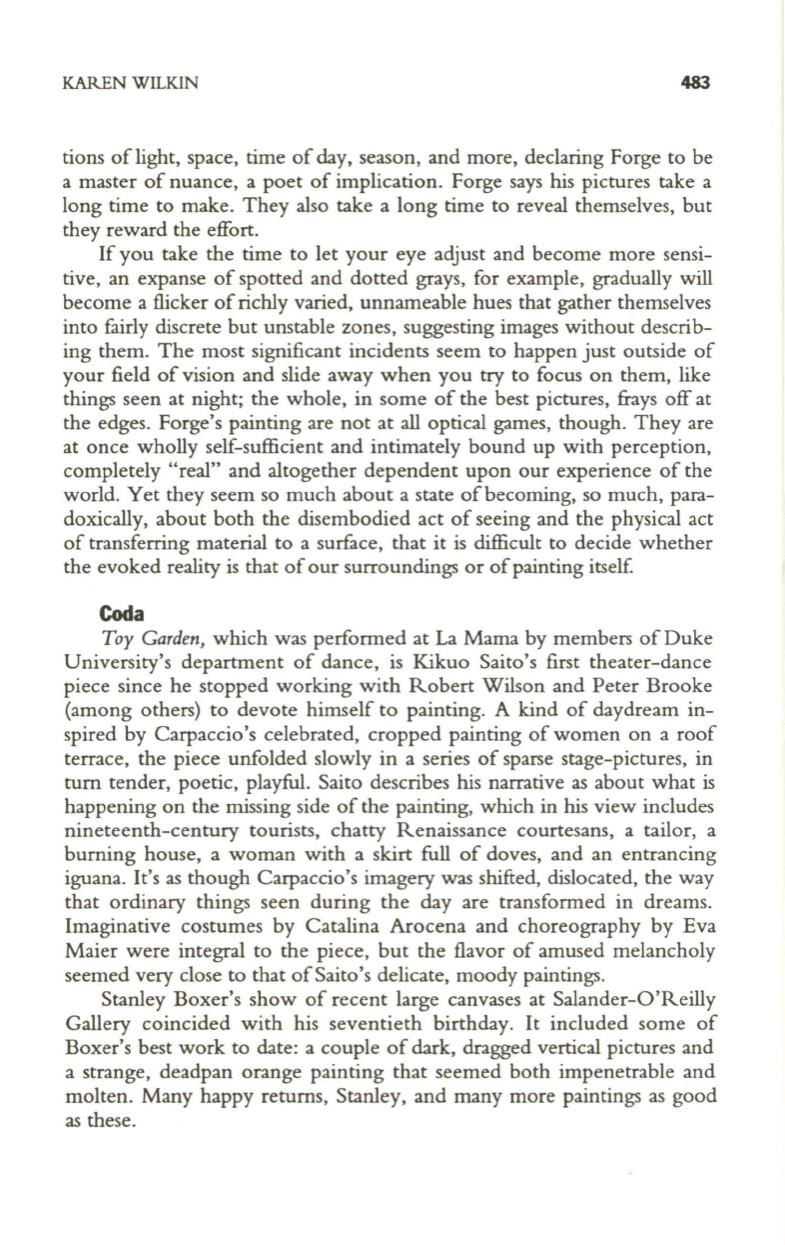
KAREN WILKIN
483
tions oflight, space, time of day, season, and more, declaring Forge to be
a master of nuance, a poet of implication. Forge says his pictures take a
long time to make. They also take a long time to reveal themselves, but
they reward the effort.
If you take the time to let your eye adjust and become more sensi–
tive, an expanse of spotted and dotted grays, for example, gradually will
become a flicker of richly varied, unnameable hues that gather themselves
into fairly discrete but unstable zones, suggesting images without describ–
ing them. The most significant incidents seem to happen just outside of
your field of vision and slide away when you try to focus on them, like
things seen at night; the whole, in some of the best pictures, frays off at
the edges. Forge's painting are not at all optical games, though. They are
at once wholly self-sufficient and intimately bound up with perception,
completely "real" and altogether dependent upon our experience of the
world. Yet they seem so much about a state of becoming, so much, para–
doxically, about both the disembodied act of seeing and the physical act
of transferring material to a surface, that it is difficult to decide whether
the evoked reality is that of our surroundings or of painting itself
Coda
Toy
Garden,
which was performed at La Mama by members of Duke
University's department of dance, is Kikuo Saito's first theater-dance
piece since he stopped working with Robert Wilson and Peter Brooke
(among others) to devote himself to painting. A kind of daydream in–
spired by Carpaccio's celebrated, cropped painting of women on a roof
terrace, the piece unfolded slowly in a series of sparse stage-pictures, in
turn tender, poetic, playful. Saito describes his narrative as about what is
happening on the missing side of the painting, which in his view includes
nineteenth-century tourists, chatty Renaissance courtesans, a tailor, a
burning house, a woman with a skirt full of doves, and an entrancing
iguana. It's as though Carpaccio's imagery was shifted, dislocated, the way
that ordinary things seen during the day are transformed in dreams.
Imaginative costumes by Catalina Arocena and choreography by Eva
Maier were integral to the piece, but the flavor of amused melancholy
seemed very close to that of Saito's delicate, moody paintings.
Stanley Boxer's show of recent large canvases at Salander-O'Reilly
Gallery coincided with his seventieth birthday. It included some of
Boxer's best work to date: a couple of dark, dragged vertical pictures and
a strange, deadpan orange painting that seemed both impenetrable and
molten. Many happy returns, Stanley, and many more paintings as good
as these.


